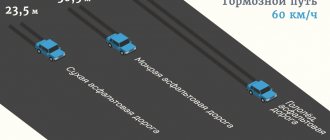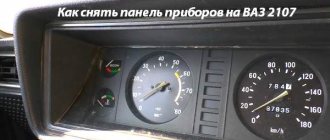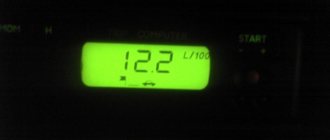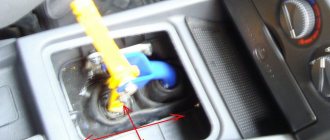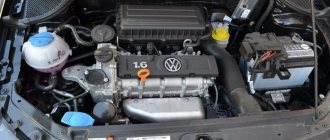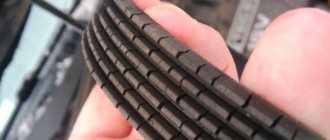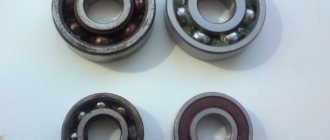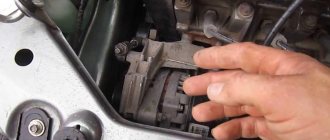Currently, all trim levels of Lada Vesta and XRAY cars, as well as “Lux” versions of Lada Granta and Kalina with AMT (robot), are equipped with a hill start assist system (HSA or HHC). It makes starting on slopes easier by holding the vehicle in place and preventing it from rolling down the slope. Let's figure out how it works and what reviews the owners of these cars leave about it.
What to do if the car stalls and won’t start
If the car stalls on the road, you will not always be able to cope with this frequently occurring problem.
Check whether your vehicle poses a risk of accidents or interferes with other road users. If trouble occurs in the middle of the road, it is important to try to roll the vehicle to the side of the road. Be sure to put up an "Emergency Stop" sign.
Start by checking the fuel level in the tank. Very often the car stalls only because you did not refuel your iron horse in time. Please note that even the most complex measuring instruments have a certain error in the indicators given. It’s better to add some fuel to the tank from a canister and try to start your car again. If you did not achieve your goal, then the cause of the incident lies in something else.
Next, you need to check whether the spark plugs are producing a spark. The contacts may come loose or oxidize due to humidity. In this case, carefully disconnect the plugs and then connect them back. If oxidation occurs, the contacts will have to be carefully cleaned.
If the spark plugs are filled with gasoline, dry them. Then blow out the cylinders. To do this, just turn on the starter. If they are flooded with gasoline again, you will have to use the help of other car owners or resort to evacuation services. Also, the spark may disappear if the spark plugs have exhausted their service life or become damp.
If there is a spark, but the engine still does not start, check to see if an element such as a fuse has blown. Always carry spare spark plugs and other parts that are at risk of failure. You can try to restore a blown fuse using a strip of cleaned wire. Additionally, examine the control unit and carefully wipe it outside and inside if you notice moisture there.
If the starter fails, there is no point in turning it. As long as there is residual charge in the battery, there is a possibility that you will be able to start while driving. You need to push the car if the road goes downhill or use a cable to attach yourself to another car.
If you are unlucky and the fuel pump is “covered,” then no fuel flows into the carburetor and it cannot work. The simplest option: a steam plug has formed. Just wait for it to evaporate on its own. It is enough for the fuel pump to cool itself. In all other cases, you will have to get to the service.
Source
How to start downhill?
This expression means that you need to start moving from the mountain. It is easier to start downhill than in a straight line. To do this you need:
- While holding the brake, depress the clutch and engage the gear.
- Release the brake.
- Smoothly release the clutch and start moving.
There is no need to step on the gas. Under the influence of gravity, the car itself will begin to coast. In this case, the clutch can be released faster.
TOP 5 reasons why a car stalls while driving and won’t start
It happens that you buy a new car, and at first it starts up great. Then something wrong happens - everything doesn’t work. The problem when a car stalls while driving and does not start is one of the most discussed problems among motorists today. Five most common reasons:
- lack of fuel;
- pump failure;
- filter contamination;
- ignition failure;
- sensor malfunction.
Some of them can be easily fixed by an experienced driver with his own hands, but some problems can only be solved with the help of repair shop employees.
VAZ 21093i Problem stalls when starting off - question about the VAZ engine
Question:
It all started with the fact that I was driving somehow and the car just stalled. When I turned on the ignition, the electric fuel pump did not work. They towed it away (luckily my father had a car). The next day I went to the garage to figure it out, just for fun, I turned on the ignition and lo and behold, the gasoline was already humming... I charged the battery and it seems like the problem was solved... After 2 weeks I went to the city somewhere, stopped at a traffic light and the car stalled again, but this time the gasoline worked, but it wouldn’t start, no way... They towed it away. Then I changed the ELV grid, tried to start it, all the cylinders were filled with gasoline , the last one got into the oil, changed the oil, spark plugs, started it after a long trouble. It works purely at idle. Let me pump it up, I’ll check it in action, I stick it in first and start moving and... I stall... well, I think I’m out of the habit, it doesn’t happen to anyone, more gas, I took off, I'm driving slowly around the yard, the car jerks and stalls again... I start it at idle, it works and I accelerate at idle, everything is fine, but under load it stalls (that is, in gears). I measured the compression at 1-10.5, 2-13.5, 3 -13.5, at 4-12.5... I turned off the mass air flow sensor, tried to drive it, no changes, I haven’t seen this before... The BC does not show errors... If anyone has encountered this, please help with advice. Thanks in advance!
Answers:
— How did gasoline get into the oil?
- Yes, it’s not clear. Either through the valves or through the cylinders. I was surprised.
— Check the condition of the RTD and injector harness.
— Yes, I’ll do this tomorrow. I’m still afraid the mass air flow sensor is dead. I should just try to install it in the store and see if it’s better or worse. And what’s the normal fuel pressure in bars? I’d like to measure it
- 3v - when on. ignition, 2.4-2.45 in operation at idle.
— and here’s another option: could the oxygen sensor affect the injection? We advised you to check it; here’s another option: could the oxygen sensor affect the injection? They advised you to check it
— When starting the engine, DC readings are not taken into account. Your car may not include a recreation center!
— it’s clear. No, it seems to be worth it, but I definitely haven’t looked. It’s just that when you give more gas and drive at higher speeds with the clutch slightly depressed, it’s even less so. Well, so that you can at least drive into the garage
Engine operating conditions
Modern cars are complex, well-thought-out mechanisms, where all structural elements are complemented or reinforced. For stable operation of the motor, the following parameters must be observed:
- Sufficient fuel and air supply. If the proportions are violated, the engine may become unbalanced and become unstable.
- Correct spark timing for gasoline internal combustion engines. If the ignition system is not calibrated correctly, the spark will fire late or early, which will significantly reduce engine performance.
- Normal compression in the cylinders. When the working chamber is depressurized, the energy released after fuel combustion goes into the crankcase, where it is dissipated. This effect causes the fuel supply system to supply more mixture and consume it in larger quantities. Additionally, this may cause interruptions in the operation of the internal combustion engine.
- Normal condition of internal parts and mechanisms. If the cylinder-piston group is worn out or damaged, it can cause the unit to become unbalanced, stop abruptly, and even jam.
If all conditions are met, the power plant will operate in standby mode. For a sudden stop, the occurrence of even one of the described factors is sufficient.
Typical parameters
Each engine has its own parameters that differ from the calibration of analogues. Each motor is characterized by a certain configuration of auxiliary equipment and its main parts.
Compression ratio and compression
Existing concepts have become overgrown with myths and misconceptions among car enthusiasts. What is known for certain is that compression affects starting the engine and maintaining its operating speed at a given level, with minimal fuel consumption.
The compression ratio, in principle, cannot influence the sudden stop of the power plant. The indicator characterizes the ratio of the volume of space above the piston at TDC and BDC. The greater the difference, the better, but not always.
Fuel supply
In modern internal combustion engines, proper fuel supply is the most important factor in their normal functioning. The injector design is more complex than an outdated carburetor. Thus, in classic engines, minor disturbances in the intake system had a minimal impact on performance.
The injectors are sensitive to minimal changes in tattooing. Thus, a simple failure or blockage of several injectors can shut down the internal combustion engine in 2-3 seconds.
Control unit and sensors
The next important parameter is the correct programming of the ECU and sensor response. The point is this:
- The sensors transmit information to the ECM about the state of the internal combustion engine at each moment in time.
- Control units read data and, depending on the impulses, send commands to electronic devices, thereby stabilizing the engine.
If the procedure is violated (wear of sensors, severe battery discharge, mechanical damage to electronics), sudden failures can occur, which often causes installation failure.
Timing
The next important parameter is responsible for the proper circulation of gases in the combustion chamber. Setting up the valve system and calibrating them guarantees timely exhaust removal and correct filling with a new portion of the fuel mixture.
If the gas distribution mechanism is not calibrated correctly, the car may stall at full speed or may not start.
Sparking
The next important parameter is directly responsible for the ignition of the mixture. The correct moment of spark formation is established by calibrating the distributor or ECM. If the device malfunctions, the entire system does not work correctly and critical interruptions in engine operation occur, which can cause its sudden failure.
Dips when pressing the gas pedal - carburetor
As noted above, the problem occurs in VAZ 2107, 2106, 2109 cars that have a carburetor installed. Mainly problems with the fuel system . It will most likely be clogged. Therefore, to identify the cause, the fuel supply to the carburetor is checked.
As a result of clogging, the operation of the fuel pump decreases, and the carburetor begins to receive less fuel. As a result, the engine starts and idles without problems, but when pressed, failures occur.
Contact qualified specialists. With us you can choose a car service that is closer to you and ask for help. They will help you with your problem.
If everything is fine with the fuel system, then the fault must be looked for in the carburetor. It is responsible for dosing the supplied fuel into the air flow. If there are violations, failure occurs. However, first you need to check for air leaks . The carburetor may become loose, allowing air to leak through the gap, making the mixture lean.
The filter mesh must also be checked. It is located in the inlet fitting of the pipeline that goes to the fuel pump. If it is contaminated, then this is a consequence of failures.
Dips when pressing the gas pedal on the carburetor:
What to do
The first reason is the fuel system and pump
Diagnostics consists of several stages, taking the form of a visual examination:
- Checking the filling status of the tank with gasoline.
- Fuel pump operation.
- Filter cleanliness.
- Cleanliness of fuel injectors.
- The ignition system is working properly.
- Serviceability of the electronic control unit.
Insufficient amount of gasoline in the fuel tank is the most common reason for engine stopping. Experienced drivers know that the gas tank level arrow readings should not always be trusted, especially when it comes to older models.
The second most common reason that requires appropriate diagnostics is failure of the fuel pump. As a result of a breakdown, the device stops pumping the combustible mixture into the engine. In addition to a visual inspection, the problem is also revealed by the characteristic buzzing sounds made by the pump’s electric motor, which it makes even after the ignition is turned off. Additionally, the condition of the device is checked using a pressure gauge - its readings must be at least 2.7 atmospheres.
A clogged filter means that even with a working pump, fuel cannot flow to the engine. The filter element of good devices does not allow even the smallest particles of debris to pass through, which are contained in almost any fuel, but as a result it becomes dirty quite quickly.
The cleanliness check is carried out using the starter turned on - it is activated by first removing the hose coming from the filter. If a stream of gasoline flows, everything is in order; when not, the filter element needs to be replaced.
Not only the filter, but also the injectors can become clogged easily, especially if the fuel quality is average or lower. To diagnose them, remove the ramp and move it aside. Crank the starter - during normal operation of the system, the nozzles spray the combustible mixture. If there is no such effect, then the driver has encountered a breakdown.
The second reason is the ignition system
This is a problematic element in the car. When there is no spark, the engine will not be able to work. But more often it does not exist due to breakdowns of the wire or spark plugs, thanks to which a spark occurs and its strength is sufficient to initiate the operation of the power plant. Visually, on properly working spark plugs there is no deposit on the working surface and the gap between the electrodes is sufficient. Plaque or lack of clearance directly prevents the formation of a spark.
Faulty wires often have damaged insulation, causing current charges to flow from them to the crankcase. Check the formation of a spark by first unscrewing the spark plugs and placing them on the valve cover. Having done this, the starter is turned sharply and wait for a distinct spark to appear on the electrode of the spark plugs. In case of its complete absence, replacement of the latter is required.
The third reason is ECU problems
The electronic control unit is of particular importance for the proper operation of the engine, because its sensors in a modern car actually control the operation of each element of the system. Therefore, the failure of one or more such sensors leads to the inoperability of the power unit. If the previous diagnostics did not reveal other problems, then there is a high probability that a failure in the ECU is responsible for the fact that the car stalled. Particular attention should be paid to two sensors:
- crankshaft rotation speed;
- camshaft positions.
If any of them is faulty and does not give the required signal, the spark plugs cannot produce a spark. Also look at the contact connectors, which often fly out of their sockets while driving. To diagnose faults, you may need a special tester. You have a better chance of dealing with this problem if you contact a specialized service center.
Possible consequences of flashing the ECU
Using low-quality and untested software for the chip, you can add unsupported fuel supply, turbine boost, etc. circuits to the on-board device. The computer and car will malfunction. Carefully monitor and check the quality of the software used.
Gas distribution mechanism (GRM) and breakdown of internal parts of the power unit
The procedure is performed on a cold engine, due to contact with its internal parts - heated parts can cause burns.
For correct diagnosis, you should open the cylinder head cover and inspect the timing belt/chain. If the parts are heavily worn, the camshaft may lag slightly behind the crankshaft, which causes the valves to malfunction or even be damaged. You should also study the location of the marks. There are special notches on the pulleys/gears that match the marks on the belt/chain. If, due to wear, the mechanism has turned or the marks have jumped, the valves are checked and the design is set according to the factory instructions.
If this is detected, you need to check the tensioner. If the device is working properly, the timing chain/belt will need to be replaced.
The worst thing is the breakage of the connecting element. In this case, the valves can bend, which can lead to serious engine repairs.
A few more possible reasons why a car may stall while driving
There are a number of breakdowns that are not directly related to the engine. Malfunctions can cause sudden failure of the power plant or its unstable operation.
Generator malfunction
The generator unit is responsible for recharging the battery while driving. If the device fails, the battery takes on the entire load and quickly discharges. Once the battery is completely discharged, the spark weakens or disappears completely, causing the engine to stop working.
Electrical wiring problems
Similar troubles often happen with old equipment, where the factory wiring has worn out or has been repaired several times. To fix the problem, you need to check all the wires responsible for the operation of the power plant.
Idle speed control
An incorrectly installed position of the nozzle in the carburetor or the valve on the injector can provoke failure of the unit at low speeds. Problems can also arise during gear shifts, when the load on the motor is removed. Often all it takes to fix it is flushing the system and cleaning the valves.
Low quality fuel
The next common factor is low-grade fuel. Low-quality fuel burns poorly and often contains foreign impurities that cannot support engine operation. To eliminate it, just drain the surrogate and fill the car with high-quality fuel.
Too much moisture has entered the fuel
When gasoline or diesel is saturated with moisture, its properties are lost and performance characteristics are significantly deteriorated. If water gets into the engine, the internal combustion engine suddenly stalls and will no longer start. The only way out is to purge the entire system.
Clogged air filters
A clogged air duct prevents oxygen from flowing into the system. After replacing the worn element, the unit begins to function normally.
Fuel filter clogged
The car reacts worse to the accelerator pedal, acceleration decreases and overall performance drops. If the cross-country ability becomes critically reduced, the engine will stall.
Exhaust system blockage
Some car enthusiasts do not pay enough attention to the exhaust system. The engine may stall when the catalyst or particulate filter becomes clogged. To eliminate the breakdown, the clogged element is replaced.
The car stalled at idle and will not start
The car owner starts the car and accelerates with the engine already warm. It seems that everything is working fine, but as soon as he stops pressing the trigger, the power plant stalls. This usually happens due to:
- throttle valve clogged;
- throttle sensor failure;
- air filter clogged;
- idle speed sensor failure;
- poor quality fuel.
Of the above, problems with sensors can only be solved by replacing them. Throttle valve failures are determined by floating speed.
How is this possible
Many owners of cars with automatic transmission have experienced their cars stalling while driving. Most often this happens due to technical faults in the engine or when the fuel in the tank runs out. Also, a car with an automatic transmission may stall when driving over rough terrain due to too high a load on the transmission. It is also worth considering that automatic transmissions have different designs - torque converter, robotic, CVT. They react differently to the driver's actions, which under certain circumstances can lead to a sudden engine stop.
The car stalled and will not start, the starter spins at idle
Owners of Lada Priora and GAZ 2106, as well as some other brands, from time to time encounter a problem when the car stalls, does not start, and the starter spins at idle. If we exclude incidents in the form of a clogged exhaust pipe or lack of gasoline, we can identify the main reasons for what is happening:
- thickening of engine oil or freezing of diesel fuel;
- pump failure;
- rotation of the flywheel crown due to the clutch of the flywheel with the bendix;
- Bendix jamming.
These problems that prevent the car from driving can be fixed with your own hands.
The car stalled in the water and will not start
Situations when a car stalls after driving through a puddle, although not very often, do occur. This occurs due to water splashing onto the ignition system wires and sensors. The problem can be solved by simply airing it so that the moisture evaporates. You can speed up the process in hot weather by additionally wiping the devices with a dry cloth. To avoid a recurrence of the situation, it is better to use protective equipment.
From personal practice, drivers know well that when overcoming deep puddles, the crankshaft sensor often suffers due to its low location. Just wipe it down and within a few minutes the machine will be operational again. There are also more serious problems. Some car owners have to deal with engine water hammer - water gets into the engine. When this happens, the power plant makes a sound like a pop before stalling. It is better to leave troubleshooting to specialists.
The engine stalled while driving and will not start: injector
Motors with fuel injection installed on such popular car brands as VAZ 2109, 2110, 2112, 2114 are slightly different in design compared to carburetor engines. There are some peculiarities in identifying problems that cause it to stall. More often this happens due to:
- contamination of the air flow sensor;
- contamination of the throttle assembly;
- lack of fuel pressure;
- wear or jamming of the idle air regulator;
- depressurization of the intake manifold;
- malfunctions in the ignition system.
By checking the indicated elements, diagnostics of the injector operation begins, regardless of whether it has 8 or 16 valves. In general, checking the condition of the engine of such a device is more difficult than that of a carburetor. Although there are simple cases: for example, when there is no spark.
The crankshaft sensor is a fragile element of the system and replacing it is the only way to repair it. The way to find out whether it is really faulty is to use a special multimeter, available only to specialists.
Flyover exercise
How is this done mechanically?
The best way to learn how to get started correctly on a manual is to master driving uphill with and without a handbrake. There is such an exercise at any race track. The slide is performed:
- using a handbrake;
- drive without a handbrake;
To drive up a hill with a handbrake, it is important to follow the step-by-step instructions: drive onto an overpass and stop and start moving on the rise.
Procedure:
- Drive onto the overpass and stop at the “STOP” line.
- Engage neutral, raise the handbrake handle as high as possible and release all foot controls.
- Disengage the clutch, engage first gear and grab the parking brake handle with your right hand.
- Dial up to 1500-2000 rpm, release the clutch until the rear of the car settles, and then turn it on completely, lowering the lever all the way down.
- Start driving uphill without the handbrake. However, it is not possible to give it back. This will be considered a failure in the exam.
It is more difficult to drive uphill without a handbrake. But a similar technique must be mastered by all drivers in order to master the ability to climb uphill under any conditions with a faulty handbrake. To do this you need to do the following:
- Drive onto the overpass and brake on the slope.
- Keep the brake pressed, turn off the speed and release the clutch.
- Squeeze the leftmost pedal, engage first gear and release the pedal until the engine begins to lose speed. At this moment, you need to sharply increase the speed, moving your foot from the brake pedal to the accelerator and, releasing the clutch, drive up the hill.
Attention! Except for the car rolling back, high crankshaft speeds and wheel slipping are allowed. Rolling the car back means failure of the task, since in real conditions there may be another car behind.
The feet on the pedals need to be moved faster. The faster the exercise is completed, the greater the chances of maintaining the vehicle’s serviceability and the less time it will take to start moving.
This exercise will help you learn how to move away manually under a traffic light, even on a significant slope.
